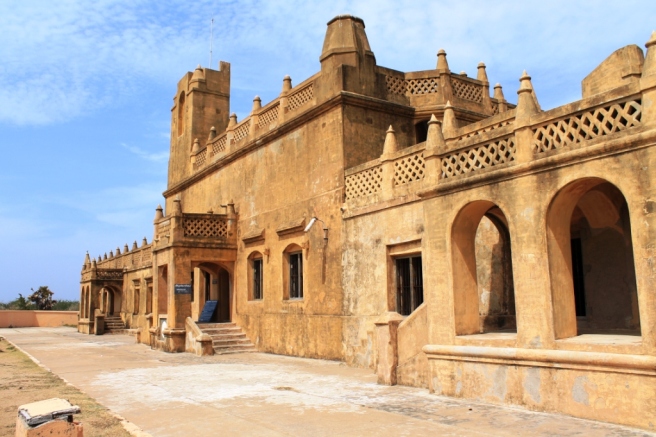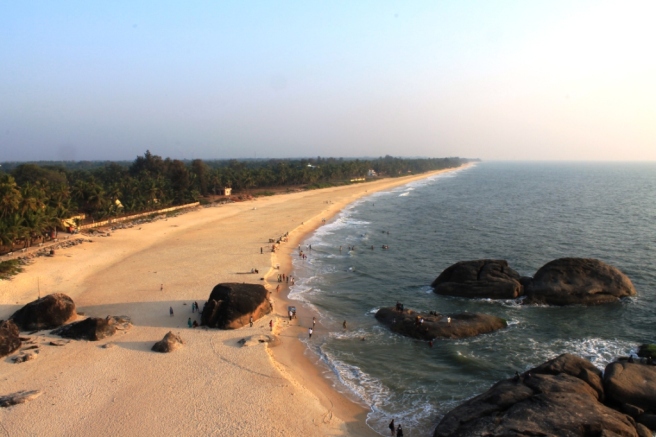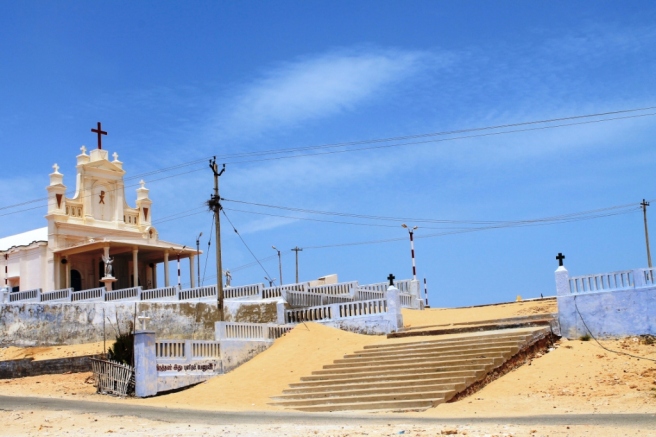In her absorbing lectures, the renowned art historian Chithra Madhavan often laments about the lackadaisical restoration work carried out by ASI in some of the temples in Tamil Nadu. Ancient murals on temple ceilings plastered over or redone tactlessly, broken structures cemented in a manner of filling cracks as if in a regular construction scenario – many temples and monuments have suffered such fate. Thankfully no such misfortune has befallen in the upkeep of the Danish fort of Tharangabadi. Though the salty breeze that taunts the structure has accounted for erosion, the fort retains its charm despite the concrete wall hugging it, smothered in fading pink paint.
Built in the year 1620 by the Danish admiral Ove Gjedde who headed the expedition on behalf of the Danish East India Company to establish trade links with India, the fort was called Dansborg (stone house) before it was anglicized when it changed hands to the British. Thanjavur’s King Ragunatha Nayaka leased out Tharangambadi to the Danes following a trade pact. Tharangabadi was subsequently sold to the English East India Company in 1845 for an amount of Rs.12.50 lakh, the deed of which can be seen on display at the museum.

Another component of Tharangabadi’s ancient history is the sea-facing Masilamani Nathar temple, which was supposed to have been built by the King Maravarman Kulasekara Pandian in 1306. Despite the Danish occupation and the ensuing conversion of swathes of population in the coastal village, the temple still stands on the shores braving the winds, gesturing religious harmony.

I arrived in Tharangabadi as early as daybreak on a weekday, ignorant of the rhythms of life in a coastal village not used to many tourists. The only tourist footfall is during holidays and weekends when hordes of people throng the fort that also houses the museum. School going children gape at me and some daring ones asked their pictures to be taken, tea shops wake up from their slumber, their copper tea pots sending up swathes of smoke and students in the many teacher training institutes that dot the King Street uniformly dressed in many hues of blue and pink saunter on.

As in any other colonial invasion, Tharangambadi also witnessed an influx of Christian missionaries from far and beyond in an effort to proliferate the reaches of Christianity. Shortly afterwards, churches were built to accommodate the growing population of devotees. The Zion Church, The New Jerusalem Church and the Lutheran Church jostle each other for space in this coastal village. Of these, The Zion Church is considered to be India’s oldest Protestant church. The missionaries also brought the first printing press, subsequently printing the bible in Tamil for distribution among the local populace.
Steeped in cultural history and architecture, Tharangambadi is also home to as many as 33 heritage buildings of which at least two of them – The Bungalow on the Beach and The Gate House provide accommodations. The Pondicherry chapter of INTACH (Indian National Trust for Art and Cultural Heritage), a non-profit working in the areas of heritage conservation and awareness is working in Tharangambadi to restore many structures in the village. Some of the structures restored include Bungalow on the beach – which was later converted into a heritage hotel run by Neemrana Hotels – and a few houses on the Goldsmith street.

Meanwhile, I trained my camera at the Landporten, the Town Gate, built to mark the entrance of Tharangambadi in the year 1660. The gate was built afresh in 1792 by the governor of the region Peter Anker at that time and bears the year on its forehead. Now though, part of it has been encroached upon by settlements, huts stand alongside the gate rubbing shoulders with it, nullifying its effect as an entrance to the village that stands testimony to a piece of history owing to its colonial past.

The fort and the museum associated with it didn’t open until after 10 a.m. and the beach is a good walk from the Town Gate – the street of which houses institutions starting from the Zion Church ending with the Bungalow by the beach property that almost touches the lip of the beach. Fisher folk prepare to set out for the day, sorting their nets out, and school bells herald the beginning of yet another day. The Masilamani Nathar temple stands facing the beach and is now awash in freshly painted glory – in preparation of an upcoming temple festival perhaps.

The fort has a rampart wall with bastions and also houses barracks, kitchen, church and lodging for the governor and other senior officials. There is also a lower storey used as arsenal storage. Though there were signboards announcing an ‘information center’ and ‘crafts on sale’, they are empty and fallen to disuse – understandably so owing to the insufficient visitors the fort attracts. The accompanying museum displays many artifacts unearthed in the area including lamps, decorated terracotta objects, sculptures, figurines, lamps and cannon balls.

On a clear day, the fort and its backdrop of azure blue sky provide excellent photo-ops. The breeze whips you up incessantly but it is a small price worth paying for a secluded spot of history tucked away in a remote corner of India’s colonial past.
Fact Sheet:
How to get there
Karaikal is the nearby town that is accessible by both road and train from major cities. From Chennai there are over night trains and from Bangalore there are buses to Pondy, from there Karaikal is 132kms away. From Karaikal, Tharangambadi is just a bus ride away (around 17kms).
Where to stay
Tharangambadi has premium range accommodations including the renovated ‘The Bungalow on the beach’ run by Neemrana hotels. If you want to do it in budget, Karaikal has numerous options providing clean and basic accommodation. I stayed at Atlantic Inn at Rs.600 per night, single bed. However, if you insist on staying on a budget, Hotel Tamil Nadu provides doubles at Rs.800 per night.
What to eat
The restaurant at the Neemrana run The Bungalow on the beach is legendary for its seafood. Tharangambadi has not too many eateries other than the tea-shacks, so plan your day accordingly if you do not want to stick around for food.
Nearby places of interest
Karaikal’s beach and port, Pondicherry’s beaches are worth visiting. If you are into temple architecture, visit Thirunallar, Thanjavur, Karaikal Ammayar Temple and the church of Basilica of Our Lady of Good Health in Velankanni.
Have you been to Tranquebar? Leave a comment and let me know.
This appeared in The Alternative and can be accessed here.






